
![]()
Introduction
Gotha in pictures
This page is also available in French
![]()
The court of the Dukes of Saxe-Coburg-Gotha had a long musical tradition: in his essay on Gluck’s Alceste reprinted in 1862 in À Travers Chants Berlioz mentions among other settings of the story one by Anton Schweitzer, a German composer contemporary of Gluck. Schweitzer was Kapellmeister at the court of the Duke of Gotha from 1778 to 1787; the opera was written for the court theatre that had been founded in 1775. Successive Dukes of Gotha in the 19th century developed Gotha’s musical activities. Duke August (reigned 1804-1822) engaged the composer Ludwig Spohr and his wife the harpist Dorothea Scheidler, and befriended Weber. His successor Ernst (reigned 1825-1844) built a new court theatre which was inaugurated in 1840 with a performance of Meyerbeer’s Robert le Diable. The next Duke, also called Ernst (born 1818, reigned 1844-1893), was the most active of all, an enthusiastic patron of the theatre and himself a composer of some ambition: his own operas were performed in Gotha and elsewhere. It was under him that Berlioz was invited to Gotha where he conducted a performance of l’Enfance du Christ on 6 February 1856.
Berlioz stated in September 1855 that he had known the Duke of Gotha ‘for a long time’ (Correspondance Générale no. 2029, hereafter shortened to CG). It is not clear when the two first met. The Duke and Duchess of Saxe-Coburg-Gotha were present at a performance of Balfe’s The Maid of Honour conducted by Berlioz at Drury Lane Theatre in London on 16 February 1848, though it is not known whether they met on this occasion. Also present were Queen Victoria and Prince Albert the Prince Consort, a younger brother of the Duke of Gotha; Berlioz dedicated his Te Deum to the Prince in 1851 (CG no. 1418). Later, in June 1853, the Prince and Queen Victoria also attended the fateful performance of Benvenuto Cellini at Covent Garden (CG nos. 1609, 1610). So did the Duke of Gotha, as is known from a letter of Berlioz to Liszt of March 1854 (CG no. 1717):
[…] I am rather ill at ease with His Highness; he regards me as a kind of semi-lunatic, and is spreading hostile reports about me in Paris. The Duke has heard Benvenuto in London, and cannot forgive me for writing a score which probably corresponds very little to his own idea of dramatic music. And besides that is the only example of my misdeeds that he knows. […]
Contacts between Berlioz and the court of Gotha had seemingly started at least as early as 1852, though the details are not all preserved. A letter dated 14 November 1852 from Berlioz to Baron von Wangenheim, the intendant of the Duke, and known only from a catalogue excerpt, gives a tantalising glimpse: ‘I confess that it would be a great heartbreak for me to be performed incompletely in the presence of such a knowledgeable judge of music as His Highness the Duke of Gotha’ (CG no. 1531). Later, in January 1854, Berlioz wrote to his friend Robert Griepenkerl, who had contacts with the court of Gotha and acted as intermediary (CG no. 1693; cf. also nos. 1659, 1793, 1893, 2090):
[…] Thank you for speaking to the Duke of Gotha about me. Is he a Royal Highness? How should he be addressed? I would be delighted to take advantage of his favourable disposition if this infernal war [the impending Crimean War] does not destroy all our plans. […]
But the first direct contact between Berlioz and the Duke of Gotha concerned not Berlioz’s but the Duke’s music. In 1854 the Duke’s new opera Santa Chiara received its first performance at Gotha on 2 April under the direction of Liszt (cf. CG no. 1717; Gotha was less than 50 kms to the west of Weimar), and the Duke had invited Berlioz, at the time in Brunswick, to attend the third performance. In reply Berlioz declined the invitation, as he was about to leave for Dresden (CG no. 1729, cf. 1717). But the opera quickly turned into an unwelcome complication. The Duke was evidently sensitive about its reception in Paris, where he intended to have it performed. Berlioz’s friend Joseph d’Ortigue reviewed the Gotha production in the Journal des Débats on 3 May 1854 (the text of this review is reproduced below), and in his letters to Liszt in April and May Berlioz makes a number of allusions to the review which imply that he found this a delicate issue (CG nos. 1738-9, 1746, 1762).
It was in this context that Berlioz was formally invited by the Duke later in the year to come and conduct his music in Gotha. Berlioz, without betraying any awareness of the Duke’s critical view of Benvenuto Cellini, responded positively (CG no. 1793, from La Côte-Saint-André, 19 September 1854):
Your Grace
I have received through my friend R. Griepenkerl the invitation you have kindly addressed me to come to Gotha to give one or two concerts next February. I am very grateful for the honour which Your Highness is bestowing on me and for the opportunity to submit to you some of my new compositions. Nothing would make me happier than to earn the genuine and well-founded approval of an enlightened judge who is a friend of the arts and himself an artist, as Your Grace is. Please be assured of my keenest gratitude.
Before my next trip to Germany I will perhaps have the opportunity to express it to you in person in Paris, where we are led to hope that you will come to supervise the rehearsals of Santa Chiara. […]
The last allusion is to the projected performance in Paris of Santa Chiara; in the event the performance only took place a year later.
Initially Berlioz intended to go first to Gotha before proceeding to Weimar, but he preferred to reverse the sequence (CG nos. 1811, 1894), and this was to cause further difficulties. In Weimar early in February 1855 Berlioz was actively planning to go to Gotha later the same month; he was in correspondence with Baron von Wangenheim (CG nos. 1893-4, 1897-8), but in the end was detained longer than expected. As he writes to his brother-in-law Marc Suat (CG no. 1901, from Weimar, 27 February):
[…] I am on the point of leaving for Gotha where I will only stop long enough to pay a visit to the Duke. I have been detained here and so overwhelmed with honours that on the day that had been earmarked for the concert in Gotha I was unable to go there, and it subsequently proved impossible to rearrange the theatre’s schedule to find another day. This has ruffled some feathers and I must go and visit the Duke of Gotha to try to prove to him my innocence in this affair. […]
The next day, now in Gotha, Berlioz wrote to Fiorentino ‘The concert in Gotha has fallen apart, and I think it will not take place. I cannot stay here, and this evening I am dining with the Duke’ (CG no. 1903). The same day, after the dinner at the palace, he writes to Griepenkerl (CG no. 1904):
[…] I have been in Gotha since yesterday; I have just dined at court where I have had the honour of speaking for a while with H.R.H. the Duchess; the Duke was ill and so could not attend dinner. Baron von Wangenheim and the Duchess made me promise to come back next year and I have undertaken to go directly from Paris to Gotha. This time there will be no misunderstanding. Farewell, I am leaving for Paris tonight. […]
The Duke’s opera Santa Chiara was eventually performed at the Paris Opéra on 27 September 1855. Berlioz evidently had very mixed feelings about the work, but was in a delicate position in view of his forthcoming visit to Gotha (he judged it prudent to include the overture from the opera at the start of his concert there; see CG nos. 2089, 2090 below). On 30 September he writes to his sister Adèle about the opera (CG no. 2029):
[…] This does not prevent the Minister of State from asking me to recommend warmly the opera of H.R.H. the Duke of Gotha, which we heard last Thursday. I replied that I had the honour of having known his Highness for a long time and that in any case I would have said about his music what needs to be said to please him. I have actually completed yesterday a pro-di-gious feuilleton which will appear in two or three days, and where truth is so closely mingled with lies that they form an indissoluble whole, which whole, being masculine, dominates completely. How did the public yawn! The Emperor slept until the ballet. […]
The review appeared in the Journal des Débats on 2 October 1855. Later in the year and the following January Berlioz was actively preparing his trip to Gotha; he was once more in correspondence with Baron von Wangenheim about practical arrangements. Joanna Pohl, wife of Richard Pohl, Berlioz’s translator and friend, would be coming from Weimar to play the harp parts, and Berlioz was to receive a fee of 200 Thalers (CG nos. 2056, 2065, 2072, 2074, 2076-7). Together with Marie Recio he left Paris on 30 January 1856 and arrived in Gotha on 1 February (CG nos. 2083, 2087), where he stayed at the Deutscher Hof (CG nos. 2090-1; the location of the hotel, which is no longer extant, is not known). On the day of his arrival (1 February) he wrote to Richard Pohl (CG no. 2089):
[…] I thank Mme Pohl a thousand times for accepting the invitation of Baron von Wangenheim, I could not have done anything without her. The programme is as follows:
1o The overture to Santa Chiara
2o Le Spectre de la rose (a melody for contralto and orchestra), sung by Mme Falconi. I will be hearing this piece for the first time.
3o L’Enfance du Christ
There is a harp part in le Spectre de la rose, but Mme Pohl will be able to see it after her arrival on the 4th and before the rehearsal on the 5th.
I do not know a soul or a single writer in Gotha. I do not know the name of the editor, and neither do I know the name of the newspaper. […]
The following day (2 February 1856) he reported on progress to Griepenkerl (CG no. 2090):
I am in Gotha since yesterday. Everything is in place, we are having the first rehearsal today at 4 o’clock. There will be another three with the orchestra on Monday, Tuesday and Wednesday [4-6 February]. I can already see that I was right to choose l’Enfance du Christ for this concert; the Kapellmeister (Lambert) and Mme Falconi seem very pleased with what they have heard. I had dinner with the Duke yesterday; he is very pleasant and gracious. I have asked to start this concert with his overture to Santa Chiara, which I must study with him tomorrow. […]
The concert took place as planned on 6 February, almost certainly in the Hoftheater in the city and not in the much smaller Ekhof-Theater in the palace; Liszt came specially from Vienna to be present. Afterwards he travelled with Berlioz to Weimar, from where Berlioz wrote to Hans von Bülow on 12 February (CG no. 2100):
[…] We recently gave a fairly good performance of l’Enfance du Christ in Gotha; I had a good Virgin Mary, Mlle Falconi, and other intelligent singers who sang their parts well enough. Among all my works this one seems most attuned to the German public. The mystical chorus at the end, « O mon âme », made a particularly great impression in Gotha. […]
Back in Paris Berlioz gave further details about his experiences. To his sister Adèle (CG no. 2104, 3 March; cf. no. 2106):
[…] I received the usual welcome in Germany […] l’Enfance du Christ was very well performed in Gotha. The Duke granted me his cross and showered me with invitations and compliments. The Duchess, who is a virtuoso herself, was also very kind to my wife. We were both invited to the ball at court on Shrove Tuesday [5 February] and to the dinner which followed. […]
To Auguste Morel (CG no. 2128, 23 May; cf. no. 2129):
[…] I gave l’Enfance du Christ in Gotha, where the Duke showered me with marks of esteem and decorated me. I heard there for the first time Le Spectre de la rose, a song with orchestra from my Nuits d’été. This has caught on so much that a German publisher [Rieter-Biedermann] asked me to orchestrate the other pieces in this collection and bought them from me. This is now done; the score is being engraved in two languages in Leipzig. […]
Le Spectre de la rose was dedicated to Mlle Falconi, who sang the performance in Gotha and gave the next three performances of the orchestral version in 1856 and 1857. Perhaps one might also note that nowhere in his extant letters does Berlioz mention the reception given to the overture to Santa Chiara at the Gotha concert.
![]()
The concert of February 1856 was the only one Berlioz gave in Gotha. Shortly after his return from Germany he became engrossed in the composition of Les Troyens, and this interrupted the continuous series of trips to Germany he had been making in recent years. The only contact he is known to have had subsequently with the Duke of Gotha was in 1859 when he wrote to him concerning a projected performance in Paris of the Duke’s new opera Diane de Solanges, for which he urged that the singer Rosine Stoltz should be entrusted with the leading role (CG no. 2382, 6 July; cf. 2336, 2338, 2354, 2361). The letter, like his previous ones to the Duke (CG nos. 1729, 1793), is notable for its formality and politeness, despite the success of the visit of 1856. Berlioz evidently never felt the same warmth towards the Duke as he felt towards other German aristocrats, such as the Prince of Hohenzollern, the King of Hanover, or the Grand Duke of Weimar. There was also some friction between the neighbouring courts of Weimar and Gotha: Liszt promoted in Weimar Benvenuto Cellini, an opera the Duke disapproved of (CG no. 1717). It was curiously tactless for Princess Sayn-Wittgenstein to wish to invite the Duke to hear the opera performed in Weimar in 1856 and even suggest to have it staged in Gotha, a suggestion Berlioz did not wish to pursue (CG nos. 2093, 2094). But for Berlioz the main obstacle may have been the Duke’s own music and his composing ambitions. It is perhaps no accident that Berlioz’s relations with Gotha are nowhere mentioned in the composer’s Memoirs: Gotha did not evoke in him the same affection as did other German musical cities such as Brunswick, Hanover or Weimar.
![]()
The modern photos reproduced on this page were taken by Michel Austin in April 2008, and the 1958 postcard of Schloß Friedenstein is from our collection. © Monir Tayeb and Michel Austin. The 1850 engraving and old photos of the Hoftheater/Landestheater are reproduced courtesy of Ursula Krãmer, Eine Residenzstadt und ihr Theater : Das tragische Schicksal des Landestheaters Gotha von 1919 bis 1951 (Verlag Frankenschwelle, 2000). The 1860 engraving of Gotha and 1939 photo of the Landestheater are courtesy of Kamen Pawlow, Das sehenswerte Gotha, 2006, Redaktion: Matthias Wenzel. All rights of reproduction reserved.
The Hoftheater Gotha, where Berlioz conducted L’Enfance du Christ in 1856, was inaugurated on 2 January 1840 and completely destroyed a hundred years later in the Second World War.
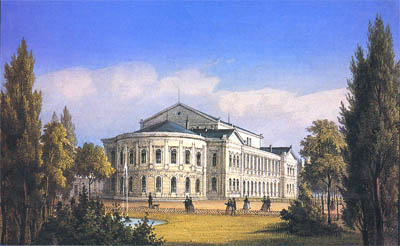
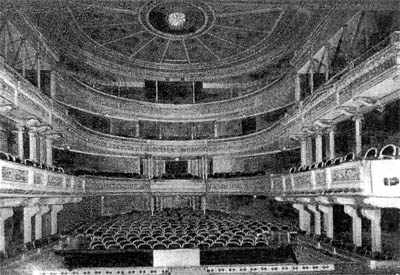
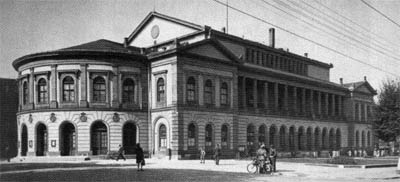
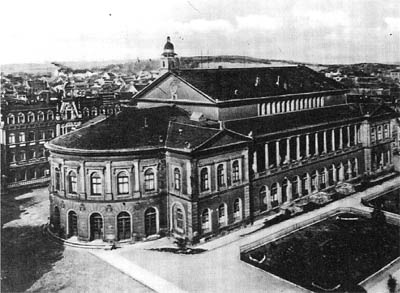
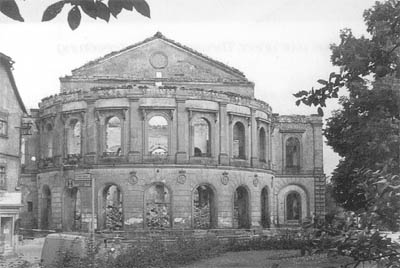

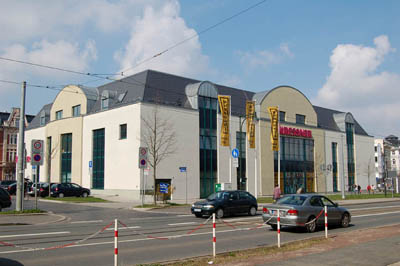
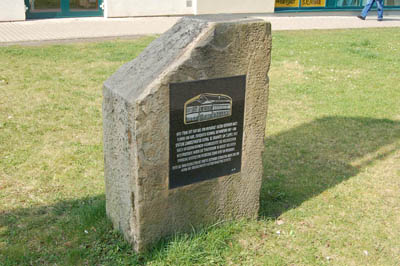


The text on the commemorative plaque reads: On this spot stood since 1840 the Hoftheater, later called Landestheater, which was built by Gustav Eberhard, the court director of works, following plans by Karl Friedrich Schinkel. It was destroyed by fire on 3 April 1945 as a result of the war. Although it had been decided to rebuild the theatre its ruins were destroyed with explosives in August 1958. Between 1965 and 1998 a skyscraper stood in this place. This memorial stone, made from one of the original blocks of the theatre, was founded in 2001 by the Society for urban history and the preservation of the old city.
The palace was built between 1643 and 1654.
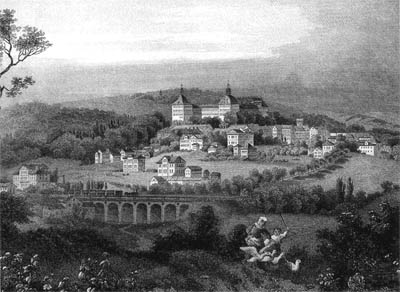
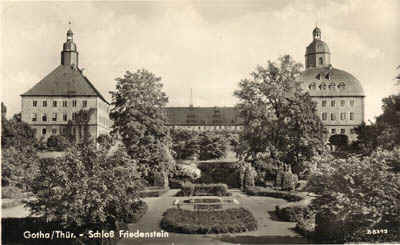
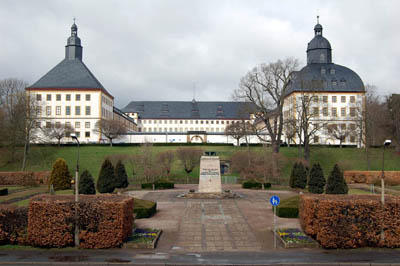

The palace’s Ekhof-Theater is located in this tower.
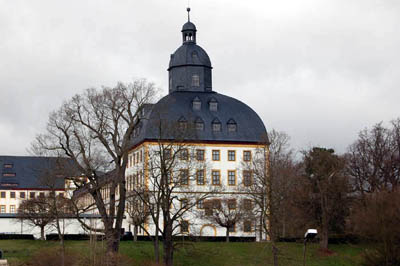
The coat of arms in the middle of the façade of this tower is shown in the following photo.
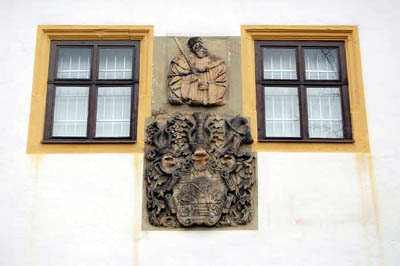
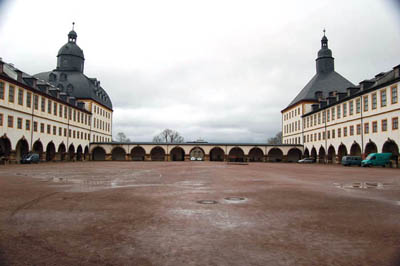
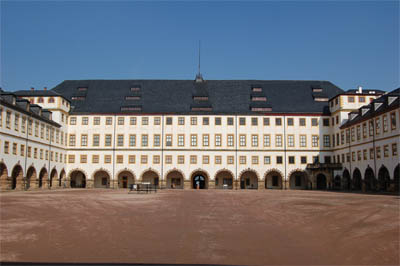

This entrance overlooks the old town.

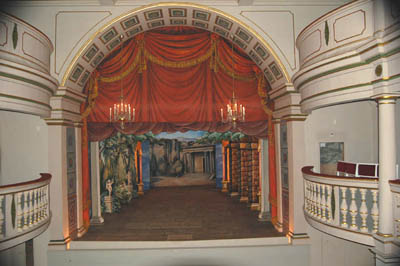
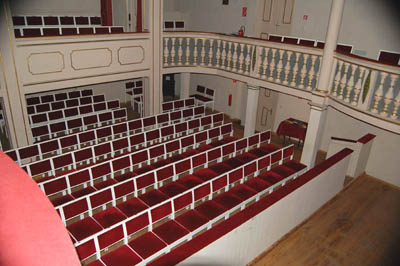
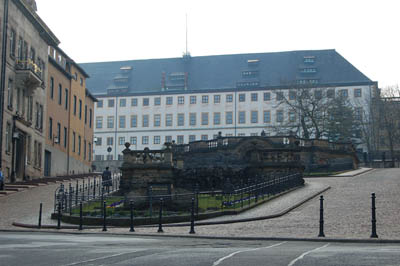
Schloß Friedenstein overlooks the old town.

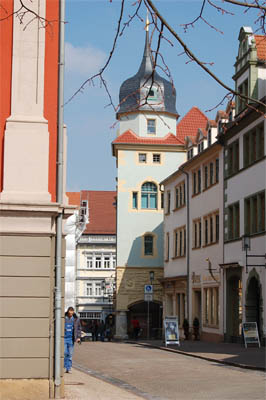
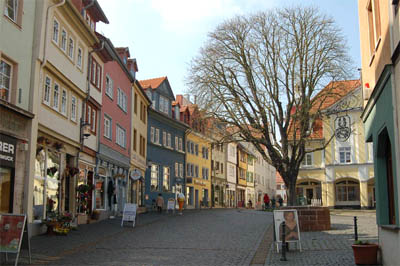
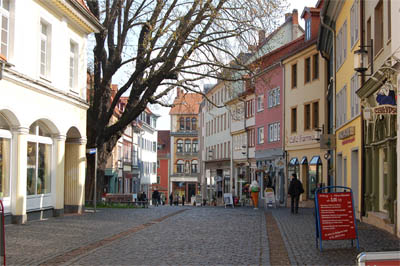
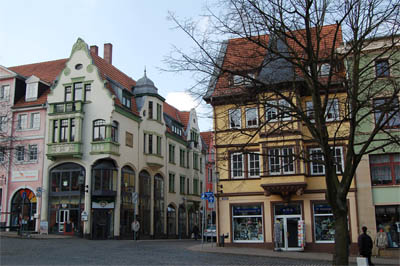
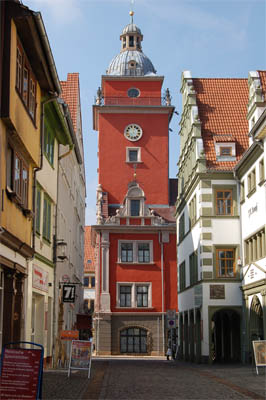
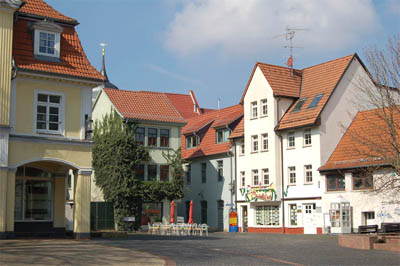
Berlioz travelled to and from Gotha by train. The pictures below show the present railway station and one of the platforms.
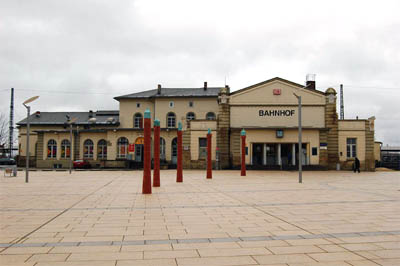
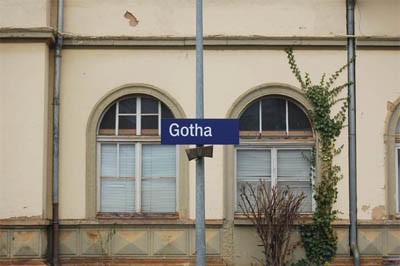
![]()
D’Ortigue’s review of the first performance of Santa Chiara (1854)
[…] Reports from Germany are full of the success just scored by the opera Santa Chiara at the theatre in Gotha. The first performance took place on 2nd April. As is well known, the music of this opera was composed by the reigning duke of Saxe-Coburg-Gotha, whom we recently saw in Paris encouraging through his presence and applause the leading artists of our theatres. Santa Chiara is the fourth opera of HRH, and there is general agreement that this work marks a huge step forward in the talent of the illustrious composer. Mention is made in the first act of a ballad, a duo and a finale, which display in equal measure a facility for melody and expertise in orchestration; but the second act is the most important, with choruses that have breadth of style and vigour. M. Reer, the tenor, let us admire his fine voice in a quintet which received great applause. The finale is the most important piece of the work, and the funeral service has terrifying impact. In the third act a chorus of wine growers of rustic jollity makes a fine contrast with the funereal mood of the preceding scenes. Then a great bravura aria, which every singer will want to make her own, was warmly applauded. M. Reer and Mme Falconi are valuable assets for Gotha’s opera house and would do credit to every stage in Europe. No need to mention the lavishness of the costumes, the stage-sets and the production: behind the good taste of the artist one can divine the generosity of the prince. As for the performance it shows admirable precision and ensemble, and is what you would expect with a conductor like Liszt, who directed all the rehearsals with the greatest care. The Count of Talleyrand-Périgord, minister plenipotentiary of the Emperor of France in Karlsruhe, was among the distinguished persons who attended the first performance of Santa Chiara. […]
Joseph d’Ortigue.
________________
Note: This short review of Santa Chiara was included in Joseph d’Ortigue’s feuilleton in the 3 May 1854 issue of the Journal des Débats, in which he reviewed a number of concerts and operas
recently performed. We have transcribed the French
text of this review from an image of the feuilleton on the website of the Bibliothèque nationale de France (Gallica
section). Translation © Michel Austin. ![]()
![]()
The page Berlioz in Gotha was created on 22 July 2006; updated on 1 June 2009. Revised on 1 March 2024.
© 2002 Ursula Krãmer and © 2006 Kamen Pawlow for old engravings and photos of Gotha and Hoftheater.
© Michel Austin and Monir Tayeb for text, modern photos and other images.